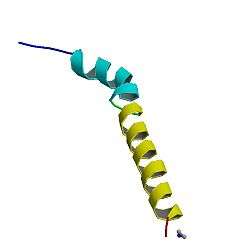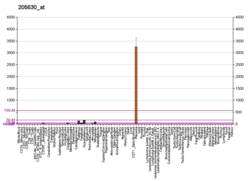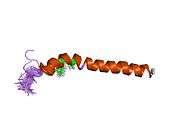Corticotropin-releasing hormone
Corticotropin-releasing hormone (CRH) (also known as corticotropin-releasing factor (CRF) or corticoliberin; corticotropin may also be spelled corticotrophin) is a peptide hormone involved in the stress response. It is a releasing hormone that belongs to corticotropin-releasing factor family. In humans, it is encoded by the CRH gene.[5] Its main function is the stimulation of the pituitary synthesis of ACTH, as part of the HPA Axis.
Corticotropin-releasing hormone (CRH) is a 41-amino acid peptide derived from a 196-amino acid preprohormone. CRH is secreted by the paraventricular nucleus (PVN) of the hypothalamus in response to stress. Increased CRH production has been observed to be associated with Alzheimer's disease and major depression,[6] and autosomal recessive hypothalamic corticotropin deficiency has multiple and potentially fatal metabolic consequences including hypoglycemia.[5]
In addition to being produced in the hypothalamus, CRH is also synthesized in peripheral tissues, such as T lymphocytes, and is highly expressed in the placenta. In the placenta, CRH is a marker that determines the length of gestation and the timing of parturition and delivery. A rapid increase in circulating levels of CRH occurs at the onset of parturition, suggesting that, in addition to its metabolic functions, CRH may act as a trigger for parturition.[5]
A recombinant version for diagnostics is called corticorelin (INN).
Hormonal actions
CRH is produced by parvocellular neuroendocrine cells within the paraventricular nucleus of the hypothalamus and is released at the median eminence from neurosecretory terminals of these neurons into the primary capillary plexus of the hypothalamo-hypophyseal portal system. The portal system carries the CRH to the anterior lobe of the pituitary, where it stimulates corticotropes to secrete adrenocorticotropic hormone (ACTH) and other biologically-active substances (β-endorphin). ACTH stimulates the synthesis of cortisol, glucocorticoids, mineralocorticoids and DHEA.[7]
In the short term, CRH can suppress appetite, increase subjective feelings of anxiety, and perform other functions like boosting attention. Although the distal action of CRH is immunosuppression via the action of cortisol, CRH itself can actually heighten inflammation, a process being investigated in multiple sclerosis research.[8]
Psychopharmacology
The CRH-1 receptor antagonist pexacerfont is currently under investigation for the treatment of generalized anxiety disorder.[9] Another CRH-1 antagonist antalarmin has been researched in animal studies for the treatment of anxiety, depression and other conditions, but no human trials with this compound have been carried out.
Also, abnormally high levels of CRH have been found in the cerebrospinal fluid of people that have committed suicide.[10]
Recent research has linked the activation of the CRH1 receptor with the euphoric feelings that accompany alcohol consumption. A CRH1 receptor antagonist developed by Pfizer, CP-154,526 is under investigation for the potential treatment of alcoholism.[11][12]
Alpha-helical CRH-(9–41) acts as a CRH antagonist.[13]
Role in parturition
CRH is also synthesized by the placenta and seems to determine the duration of pregnancy.[14]
Levels rise towards the end of pregnancy just before birth and current theory suggests three roles of CRH in parturition:[15]
- Increases levels of dehydroepiandrosterone (DHEA) directly by action on the fetal adrenal gland, and indirectly via the mother's pituitary gland. DHEA has a role in preparing for and stimulating cervical contractions.
- Increases prostaglandin availability in uteroplacental tissues. Prostaglandins activate cervical contractions.
- Prior to parturition it may have a role inhibiting contractions, through increasing cAMP levels in the myometrium.
In culture, trophoblast CRH is inhibited by progesterone, which remains high throughout pregnancy. Its release is stimulated by glucocorticoids and catecholamines, which increase prior to parturition lifting this progesterone block.[16]
Structure
The 41-amino acid sequence of CRH was first discovered in sheep by Vale et al. in 1981.[17] Its full sequence is:
- SQEPPISLDLTFHLLREVLEMTKADQLAQQAHSNRKLLDIA
The rat and human peptides are identical and differ from the ovine sequence only by 7 amino acids.[18]
- SEEPPISLDLTFHLLREVLEMARAEQLAQQAHSNRKLMEII
Role in non-mammalian vertebrates
In mammals, studies suggest that CRH has no significant thyrotropic effect. However, in representatives of all non-mammalian vertebrates, it has been found that, in addition to its corticotropic function, CRH has a potent thyrotropic function, acting with TRH to control the thyroid axis (TRH has been found to be less potent than CRH in some species).[19][20]
Interactions
Corticotropin-releasing hormone has been shown to interact with corticotropin-releasing hormone receptor 1.[21][22]
See also
- Corticotropin-releasing hormone receptor
- ACTH
- Glucocorticoids
- Proopiomelanocortin
- Hypothalamic-pituitary-adrenal axis
- Cushing's syndrome
- Addison's disease
References
- GRCh38: Ensembl release 89: ENSG00000147571 - Ensembl, May 2017
- GRCm38: Ensembl release 89: ENSMUSG00000049796 - Ensembl, May 2017
- "Human PubMed Reference:". National Center for Biotechnology Information, U.S. National Library of Medicine.
- "Mouse PubMed Reference:". National Center for Biotechnology Information, U.S. National Library of Medicine.
- "Entrez Gene: CRH corticotropin releasing hormone".
- Raadsheer FC, van Heerikhuize JJ, Lucassen PJ, Hoogendijk WJ, Tilders FJ, Swaab DF (September 1995). "Corticotropin-releasing hormone mRNA levels in the paraventricular nucleus of patients with Alzheimer's disease and depression". Am J Psychiatry. 152 (9): 1372–6. doi:10.1176/ajp.152.9.1372. PMID 7653697.
- "Corticotrophin-releasing hormone". 5 September 2012. Society for Endocrinology. Archived from the original on 20 October 2016. Retrieved 9 July 2013.
- Paul, William E. (September 1993). "Infectious Diseases and the Immune System". Scientific American. 269 (3): 112. Bibcode:1993SciAm.269c..90P. doi:10.1038/scientificamerican0993-90. PMID 8211095.
- "Study of Pexacerfont (BMS-562086) in the Treatment of Outpatients With Generalized Anxiety Disorder". ClinicalTrials.gov. 1 August 2008. Retrieved 3 August 2008.
- Arató M, Bánki CM, Bissette G, Nemeroff CB (1989). "Elevated CSF CRF in suicide victims". Biol. Psychiatry. 25 (3): 355–9. doi:10.1016/0006-3223(89)90183-2. PMID 2536563.
- "Drug Has Potential To Prevent Alcoholics From Relapsing". Science News. ScienceDaily. 2 August 2008. Retrieved 9 August 2008.
- Pastor R, McKinnon CS, Scibelli AC, Burkhart-Kasch S, Reed C, Ryabinin AE, Coste SC, Stenzel-Poore MP, Phillips TJ (July 2008). "Corticotropin-releasing factor-1 receptor involvement in behavioral neuroadaptation to ethanol: a urocortin1-independent mechanism". Proc. Natl. Acad. Sci. U.S.A. 105 (26): 9070–5. Bibcode:2008PNAS..105.9070P. doi:10.1073/pnas.0710181105. PMC 2449366. PMID 18591672.
- Santos J, Saunders PR, Hanssen NP, Yang PC, Yates D, Groot JA, Perdue MH (1 August 1999). "Corticotropin-releasing hormone mimics stress-induced colonic epithelial pathophysiology in the rat". Am. J. Physiol. 277 (2 Pt 1): G391–9. doi:10.1152/ajpgi.1999.277.2.G391. PMID 10444454.
- Kimball JW (15 June 2006). "Hormones of the Hypothalamus". Kimball's Biology Pages. 227 (5): 24–33. Bibcode:1972SciAm.227e..24G. doi:10.1038/scientificamerican1172-24. Archived from the original on 27 June 2012. Retrieved 3 August 2008.
- Lye S, Challis JR (2001). "Chapter 12: Parturition". In Bocking AD, Harding R (eds.). Fetal growth and development. Cambridge, UK: Cambridge University Press. pp. 241–266. ISBN 978-0-521-64543-0.
- Jones SA, Brooks AN, Challis JR (April 1989). "Steroids modulate corticotropin-releasing hormone production in human fetal membranes and placenta". J. Clin. Endocrinol. Metab. 68 (4): 825–30. doi:10.1210/jcem-68-4-825. PMID 2537843.
- Vale W, Spiess J, Rivier C, Rivier J (September 1981). "Characterization of a 41-residue ovine hypothalamic peptide that stimulates secretion of corticotropin and beta-endorphin". Science. 213 (4514): 1394–7. Bibcode:1981Sci...213.1394V. doi:10.1126/science.6267699. PMID 6267699.
- Chrousos GP, Schuermeyer TH, Doppman J, Oldfield EH, Schulte HM, Gold PW, Loriaux DL (March 1985). "NIH conference. Clinical applications of corticotropin-releasing factor". Annals of Internal Medicine. 102 (3): 344–358. doi:10.7326/0003-4819-102-3-344. PMID 2982307.
- Seasholtz AF, Valverde RA, Denver RJ (October 2002). "Corticotropin-releasing hormone-binding protein: biochemistry and function from fishes to mammals". The Journal of Endocrinology. 175 (1): 89–97. doi:10.1677/joe.0.1750089. PMID 12379493.
- De Groef B, Van der Geyten S, Darras VM, Kühn ER (March 2006). "Role of corticotropin-releasing hormone as a thyrotropin-releasing factor in non-mammalian vertebrates". General and Comparative Endocrinology. 146 (1): 62–8. doi:10.1016/j.ygcen.2005.10.014. PMID 16337947.
- Grammatopoulos DK, Dai Y, Randeva HS, Levine MA, Karteris E, Easton AJ, Hillhouse EW (December 1999). "A novel spliced variant of the type 1 corticotropin-releasing hormone receptor with a deletion in the seventh transmembrane domain present in the human pregnant term myometrium and fetal membranes". Mol. Endocrinol. 13 (12): 2189–202. doi:10.1210/mend.13.12.0391. PMID 10598591.
- Gottowik J, Goetschy V, Henriot S, Kitas E, Fluhman B, Clerc RG, Moreau JL, Monsma FJ, Kilpatrick GJ (October 1997). "Labelling of CRF1 and CRF2 receptors using the novel radioligand, [3H]-urocortin". Neuropharmacology. 36 (10): 1439–46. doi:10.1016/S0028-3908(97)00098-1. PMID 9423932.
Further reading
- Florio P, Severi FM, Ciarmela P, Fiore G, Calonaci G, Merola A, De Felice C, Palumbo M, Petraglia F (2003). "Placental stress factors and maternal-fetal adaptive response: the corticotropin-releasing factor family". Endocrine. 19 (1): 91–102. doi:10.1385/ENDO:19:1:91. PMID 12583606.
- Florio P, Rossi M, Sigurdardottir M, Ciarmela P, Luisi S, Viganò P, Grasso D, Fiore G, Cobellis L, Di Blasio AM, Petraglia F (2003). "Paracrine regulation of endometrial function: interaction between progesterone and corticotropin-releasing factor (CRF) and activin A". Steroids. 68 (10–13): 801–7. doi:10.1016/S0039-128X(03)00137-5. PMID 14667971.
- Vamvakopoulos NC, Karl M, Mayol V, Gomez T, Stratakis CA, Margioris A, Chrousos GP (1990). "Structural analysis of the regulatory region of the human corticotropin releasing hormone gene". FEBS Lett. 267 (1): 1–5. doi:10.1016/0014-5793(90)80272-K. PMID 2365075.
- Robinson BG, D'Angio LA, Pasieka KB, Majzoub JA (1989). "Preprocorticotropin releasing hormone: cDNA sequence and in vitro processing". Mol. Cell. Endocrinol. 61 (2): 175–80. doi:10.1016/0303-7207(89)90128-7. PMID 2783917.
- Arbiser JL, Morton CC, Bruns GA, Majzoub JA (1988). "Human corticotropin releasing hormone gene is located on the long arm of chromosome 8". Cytogenet. Cell Genet. 47 (3): 113–6. doi:10.1159/000132525. PMID 3259914.
- Sasaki A, Tempst P, Liotta AS, Margioris AN, Hood LE, Kent SB, Sato S, Shinkawa O, Yoshinaga K, Krieger DT (1988). "Isolation and characterization of a corticotropin-releasing hormone-like peptide from human placenta". J. Clin. Endocrinol. Metab. 67 (4): 768–73. doi:10.1210/jcem-67-4-768. PMID 3262120.
- Shibahara S, Morimoto Y, Furutani Y, Notake M, Takahashi H, Shimizu S, Horikawa S, Numa S (1984). "Isolation and sequence analysis of the human corticotropin-releasing factor precursor gene". EMBO J. 2 (5): 775–9. doi:10.1002/j.1460-2075.1983.tb01499.x. PMC 555184. PMID 6605851.
- Behan DP, Heinrichs SC, Troncoso JC, Liu XJ, Kawas CH, Ling N, De Souza EB (1995). "Displacement of corticotropin releasing factor from its binding protein as a possible treatment for Alzheimer's disease". Nature. 378 (6554): 284–7. Bibcode:1995Natur.378..284B. doi:10.1038/378284a0. PMID 7477348.
- Kawahito Y, Sano H, Mukai S, Asai K, Kimura S, Yamamura Y, Kato H, Chrousos GP, Wilder RL, Kondo M (1996). "Corticotropin releasing hormone in colonic mucosa in patients with ulcerative colitis". Gut. 37 (4): 544–51. doi:10.1136/gut.37.4.544. PMC 1382908. PMID 7489943.
- McLean M, Bisits A, Davies J, Woods R, Lowry P, Smith R (1995). "A placental clock controlling the length of human pregnancy". Nat. Med. 1 (5): 460–3. doi:10.1038/nm0595-460. PMID 7585095.
- Slominski A, Ermak G, Hwang J, Chakraborty A, Mazurkiewicz JE, Mihm M (1995). "Proopiomelanocortin, corticotropin releasing hormone and corticotropin releasing hormone receptor genes are expressed in human skin". FEBS Lett. 374 (1): 113–6. doi:10.1016/0014-5793(95)01090-2. PMID 7589495.
- Sutton SW, Behan DP, Lahrichi SL, Kaiser R, Corrigan A, Lowry P, Potter E, Perrin MH, Rivier J, Vale WW (1995). "Ligand requirements of the human corticotropin-releasing factor-binding protein". Endocrinology. 136 (3): 1097–102. doi:10.1210/en.136.3.1097. PMID 7867564.
- Vamvakopoulos NC, Chrousos GP (1994). "Structural organization of the 5' flanking region of the human corticotropin releasing hormone gene". DNA Seq. 4 (3): 197–206. doi:10.3109/10425179309015632. PMID 8161822.
- Perrin MH, Donaldson CJ, Chen R, Lewis KA, Vale WW (1994). "Cloning and functional expression of a rat brain corticotropin releasing factor (CRF) receptor". Endocrinology. 133 (6): 3058–61. doi:10.1210/en.133.6.3058. PMID 8243338.
- Romier C, Bernassau JM, Cambillau C, Darbon H (1993). "Solution structure of human corticotropin releasing factor by 1H NMR and distance geometry with restrained molecular dynamics". Protein Eng. 6 (2): 149–56. doi:10.1093/protein/6.2.149. PMID 8386360.
- Liaw CW, Grigoriadis DE, Lovenberg TW, De Souza EB, Maki RA (1997). "Localization of ligand-binding domains of human corticotropin-releasing factor receptor: a chimeric receptor approach". Mol. Endocrinol. 11 (7): 980–5. doi:10.1210/me.11.7.980. PMID 9178757.
- Timpl P, Spanagel R, Sillaber I, Kresse A, Reul JM, Stalla GK, Blanquet V, Steckler T, Holsboer F, Wurst W (1998). "Impaired stress response and reduced anxiety in mice lacking a functional corticotropin-releasing hormone receptor 1". Nat. Genet. 19 (2): 162–6. doi:10.1038/520. PMID 9620773.
- Perone MJ, Murray CA, Brown OA, Gibson S, White A, Linton EA, Perkins AV, Lowenstein PR, Castro MG (1998). "Procorticotrophin-releasing hormone: endoproteolytic processing and differential release of its derived peptides within AtT20 cells". Mol. Cell. Endocrinol. 142 (1–2): 191–202. doi:10.1016/S0303-7207(98)00104-X. PMID 9783915.
- Willenberg HS, Bornstein SR, Hiroi N, Päth G, Goretzki PE, Scherbaum WA, Chrousos GP (2000). "Effects of a novel corticotropin-releasing-hormone receptor type I antagonist on human adrenal function". Mol. Psychiatry. 5 (2): 137–41. doi:10.1038/sj.mp.4000720. PMID 10822340.
- Saeed B, Fawcett M, Self C (2001). "Corticotropin-releasing hormone binding to the syncytiotrophoblast membranes". Eur. J. Clin. Invest. 31 (2): 125–30. doi:10.1046/j.1365-2362.2001.00770.x. PMID 11168450.
External links

- Overview of all the structural information available in the PDB for UniProt: P06850 (Corticoliberin) at the PDBe-KB.








